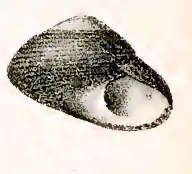Diloma coracinum
Diloma coracinum is a species of small sea snail, a marine gastropod mollusc in the family Trochidae, the top snails.[1] The Māori name is māihi.[2]
| Diloma coracinum | |
|---|---|
 | |
| Drawing of a shell of Diloma coracinum | |
| Scientific classification | |
| Domain: | Eukaryota |
| Kingdom: | Animalia |
| Phylum: | Mollusca |
| Class: | Gastropoda |
| Subclass: | Vetigastropoda |
| Order: | Trochida |
| Superfamily: | Trochoidea |
| Family: | Trochidae |
| Genus: | Diloma |
| Species: | D. coracinum |
| Binomial name | |
| Diloma coracinum (Philippi, 1851) | |
| Synonyms | |
Description
The height of the shell between 6 mm and 9 mm, its diameter between 8.5 mm and 12 mm. The small, solid, imperforate has a depressed orbicular-conoid shape. It is lustreless. This is a very variable species, and the smallest Diloma occurring in New Zealand.
Sculpture: Rather distant spiral lirae, sometimes obsolete, crossed by oblique growth-lines.
Colour: purplish-black or black, unicoloured, or sparsely dotted, especially on the base, with yellow.
The epidermis is solid, not easily eroded. The spire is low and arched, or conical with rounded apex. The protoconch consists of two flatly convex whorls, which are finely spirally lirate with very distinct oblique growth-lines. The 4 to 5 whorls are slightly convex. The body whorl is large, concave below the suture, obtusely angulate at the periphery and eroded in front of the aperture. The base of the shell is flatly convex. The suture is linear, margined below by a low and rather broad pad. The aperture is very oblique, reddish iridescent and lirate. The outer lip is convex, sharp, black-edged inside, followed by a white opaque band which continues as a pearly stripe over the umbilical tract, parallel to the columella, and connects the terminations of the peristome. The umbilical tract is bounded on the outer lower margin by green, grey, or brown. The operculum is round, light brown, horny, multispiral with a central nucleus.[3]
Distribution
This marine species is endemic to New Zealand and occurs only around the coasts of the two largest main islands, where it is most frequently found on exposed southern or west coast shores.
References
- Bouchet, P. (2013). Diloma coracinum (Philippi, 1851). Accessed through: World Register of Marine Species at http://www.marinespecies.org/aphia.php?p=taxdetails&id=546860 on 2014-03-18
- Cook, Steve De C., “New Zealand Coastal Marine Invertebrates Vol 1”, Canterbury University Press, NZ 2010, ISBN 978-1877257-60-5
- Suter H. (1913-1915), Manual of New Zealand Mollusca; Wellington, N. Z. :J. Mackay, govt. printer,1913-1915 (described as Monodonta coracina)
- Powell A. W. B., New Zealand Mollusca, William Collins Publishers Ltd, Auckland, New Zealand 1979 ISBN 0-00-216906-1
- Donald K.M., Kennedy M. & Spencer H.G. (2005) The phylogeny and taxonomy of austral monodontine topshells (Mollusca: Gastropoda: Trochidae), inferred from DNA sequences. Molecular Phylogenetics and Evolution 37: 474-483
External links
- "Diloma (Cavodiloma) coracina". Gastropods.com. Retrieved 16 January 2019.